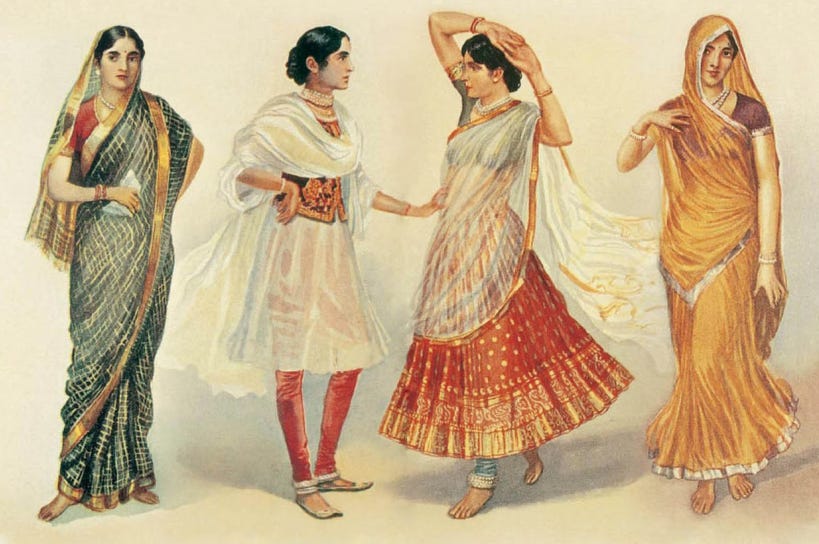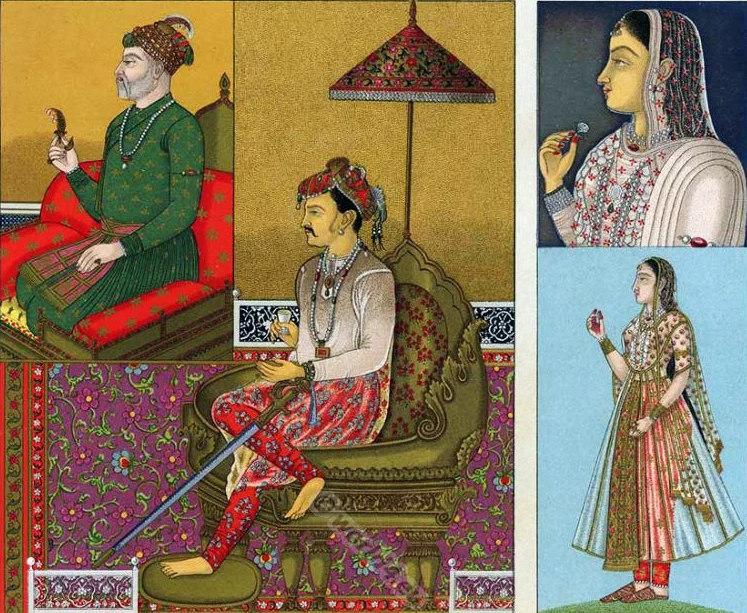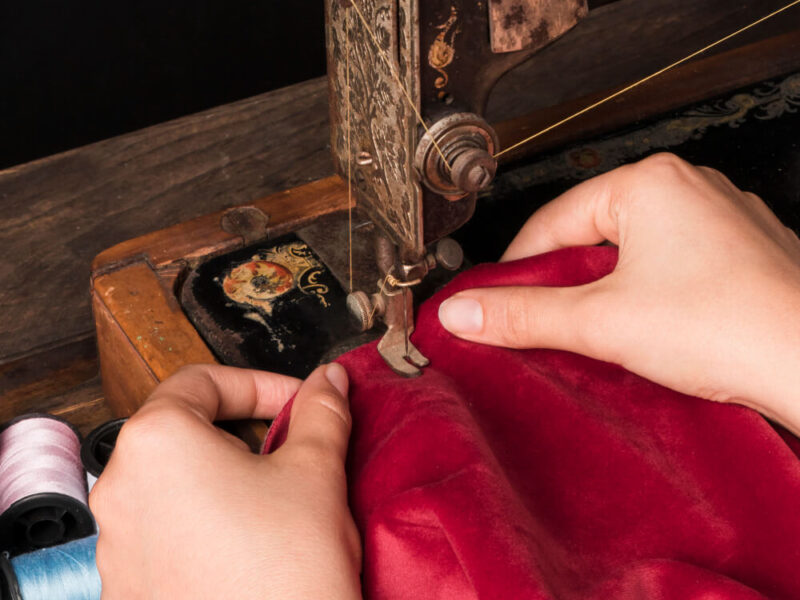In-depth history of fashion, Indian Dynasty, Mughal…
The history of fashion in ancient India is a rich tapestry woven with diverse cultural influences and legacy with evolving styles. The use of locally grown cotton, silk, and wool, along with elaborate jewelry, played a significant role in defining the attire of different eras. Mughal fashion, spanning the 16th to 18th centuries, The Mughals introduced a variety of garments such as the Jama, Paijama, and Peshwaz, made from muslin, silk, velvet, and brocade. Byzantine fashion was a blend of classical Greek roots and Eastern influences, reflecting the opulence and complexity of the Byzantine Empire.
History of Indian Dynasty

Mauryan Empire (322-185 BCE)
During the Mauryan period, both men and women wore unstitched garments called Antariya, Uttariya, and Muraja. The main garment, Antariya, was made from white cotton, linen, or muslin and was draped around the hips in a kachcha style. Uttariya was a fine cotton or silk cloth used as a long scarf to cover the upper body. Jewelry was common, with both men and women wearing earrings, necklaces, armlets, bracelets, and embroidered belts.
Gupta Empire (4th to 6th Century CE)
The Gupta period is often referred to as the “Golden Age” of India. Clothing included Antariya, Uttariya, and Kayabandh. Men wore striped blue silk with a moving Uttariya, while women wore Antariya in lehenga and kachcha styles. Hairstyles included long hair worn in a bun, tied at the side of the head, or with a spiral looped on the left.
Shunga Dynasty (185-73 BCE)
During the Shunga period, fine cotton, silk, wool, linen, and jute fabrics were widely available. Women typically wore Antariyas tied in different styles and Uttariyas as head coverings. Men wore Antariyas draped around their waists and secured with sashes. Military clothing included sewn tunics and lower Antariyas.
Satavahana Dynasty (1st Century BCE to 3rd Century CE)
The Satavahana period saw the use of Antariya and Uttariya (upper and lower garments), Kancuka (tunic), Kayabandh (waistbelt), and Ushnisha (turban). Jewelry included Lambanam, Bajubandh, Kangan, and Tikka.
Magadha (1700 BCE – 625 CE)
Magadha’s fashion evolved through various dynasties. During the Mauryan period, clothing included Antariya, Uttariya, and Muraja. The region played a significant role in the development of Jainism and Buddhism, influencing the clothing styles of the time.
Kushan Empire (30-375 CE)
The Kushan Empire saw a blend of Iranian and Greek cultural influences. Clothing included Antariya, Uttariya, and Kancuka. The Kushans were patrons of Buddhism, and their clothing reflected a mix of different cultural elements.
Pre-Vedic Period (before 1500 BCE)
During the Indus Valley Civilization, men wore unstitched lower garments or loincloths, while women wore short skirts or close-fitted tunics. Jewelry was common, with both sexes wearing necklaces, bracelets, earrings, anklets, rings, and bangles. The use of cotton, flax, silk, wool, linen, and leather was prevalent.
Post-Vedic Period (after 600 BCE)
In the post-Vedic period, many dynasties like the Mauryas, Sungas, Guptas, and Kushans, ruled. Fabrics like wool, silk, cotton, jute, linen, and muslin were widely used. Clothing styles included Antariya, Uttariya, and Kayabandh. The use of stitched garments became more common.
The Mughal Empire

Both men and women adorned themselves with intricate jewelry, and the use of vibrant colors and patterns was prevalent. The Mughal period is often referred to as the “golden period of Indian history” due to its significant contributions to art, culture, and fashion
Men’s Fashion
Men’s clothing during the Mughal era included:
- Jama: A long, overlapping coat tied at the waist with a sash called a patka. Underneath, they wore paijama (pants), which gave rise to the English word “pajama.”
- Pagri: A turban worn on the head, often adorned with ornaments made of gold and precious gems like rubies, diamonds, emeralds, and sapphires.
- Footwear: Shoes such as jhuti, kafsh, charhvan, salim shahi, and khurd nau, which were often curved up at the front.
Women’s Fashion
Women’s clothing was equally elaborate and included:
- Shalwar, churidar, dhilja, gharara, and farshi: Various styles of pants and skirts.
- Jewelry: Women adorned themselves with earrings, nose jewelry, necklaces, bangles, belts, and anklets.
- Headwear: Silk Karakul or boqta hats, often ornamented with jewels, feathered pins, and veils.
Influence and Legacy
The Mughal period is often referred to as the “golden period of Indian history” due to its cultural richness. The Mughals brought skilled craftsmen from other countries to create their elaborate garments. The Mughal-inspired tailored salwar kameez became popular and continues to influence Indian fashion today.


